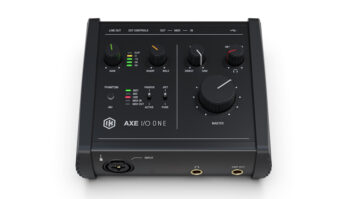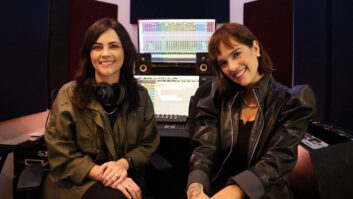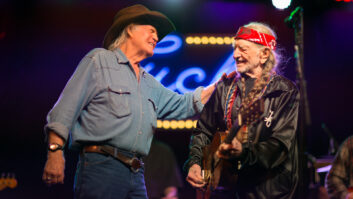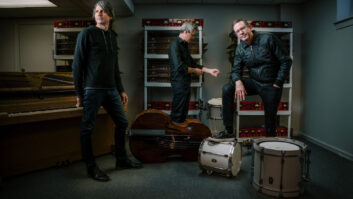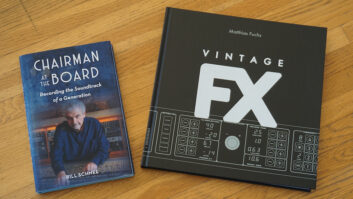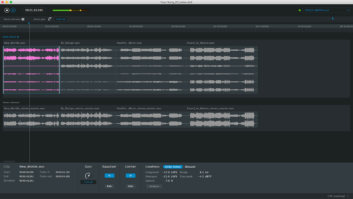
Greg O’Keeffe (left) and Mikael Jorgensen
Photo: Allen Farmelo
The latest from Wilco keyboardist Mikael Jorgensen is a collaborative record that took years, and a couple of different forms, to arrive. Jorgensen and drummer Greg O’Keeffe—longtime friends who have been bouncing musical ideas off of each other since they met in 1995—kept things loose at first, with writing/demo sessions in their personal studio (Brooklyn, N.Y.).
“Throwing some mics up and recording improv is a great way to generate ideas, especially now that we have families and our time in the studio is less luxurious,” Jorgensen says. “It was a good way to start. Then I took the raw recordings and refined some of the song ideas. We did some more demo’ing and some more overdubbing and then said, ‘Let’s go record properly.’”
They booked a few days in The Bunker Studio with the idea of laying down permanent basics. “This was the former Bunker studio—they’ve since moved to a larger space—but it’s the same gear and same great vibe and atmosphere,” Jorgensen explains. “We recorded 12 or 14 songs very traditionally: guitar, bass, drums, keyboards, acoustic guitar and scratch vocals.”
Jorgensen took the tracks back to their personal studio—which he says is “a humble little barely climate-controlled space”—to flesh out parts and arrangements. He soon found himself bored with the results and the process, and then hit on the idea of replacing most of the instrument parts with synth sounds.
“I use synths on records all the time, but I hadn’t viewed them as the integral part—the sonic core,” he explains. “More traditionally, I’ve used a guitar or piano part to form the harmonic structure. But I thought, if I replace everything with synths, everything’s on the table.
“I worked on the first song on the record, ‘Armz,’” he continues. “The initial version was a breezy, ’70s acoustic, open-tuning kind of thing, more Stephen Stills than Kraftwerk.” Jorgensen built a new electronic arrangement using mainly his Moog Little Phatty for bass parts, an ARP 2600 to re-create melodies and harmonics, and his EMS Synthi for more “squiggly electronic sounds.”
“I replaced everything but Greg’s drums,” he says. “I thought, ‘This is awesome, but holy shit, I have so much more work to do now.’”
Recording to Pro Tools, Jorgensen dug into his synths and effects until the tracks grew into new, unique sonic worlds. “The chain would usually be the synths through a Moog analog delay and the [Electro-Harmonix] Holy Grail reverb and a Source Audio Soundblox [Tri-Mod] phaser—it’s got a good Mu-Tron-style phaser, which I used quite a bit—and then also a Fulltone Tube Tape Echo tape delay.”
Post-effects, Jorgensen’s synths all went through a Universal Audio LA-610 channel strip before going into his RME Fireface 800 audio interface. “The LA-610 helped beef things up, round the edges and make it sound really thick, which is very satisfying,” he says.
After working away for a while, bouncing his new ideas off of O’Keeffe, Jorgensen felt he needed a fresh perspective, so he played some rough mixes for producer/engineer/ Butterscotch label head Allen Farmelo.
“I brought him to my studio and told him, ‘Here are the ingredients,’ and I brought up the Pro Tools session. He heard it and said, ‘I want to do this so badly. I’ll mix the whole record.’”
At that stage in the album’s evolution, Jorgensen had an infant son at home, so it was a great relief to pass the tracks along to someone who could focus on the details. “Allen would work on a song, and my son and I would come over to his studio and listen. Allen would get it 90 to 95 percent there, and I would just make a few little tweaks,” Jorgensen says.
Most of the songs became something completely different from the rock tracks Jorgensen and O’Keeffe had made in The Bunker. “Armz” is still very tuneful and rhythmic, but hissy, processed synths continually buzz in and out and weave around each other. “Where to Begin,” which Jorgensen says started as “acoustic and finger-picky,” features a creepy processed Jorgensen vocal on top of choir-like keyboard tones.
There is, however, a lone guitar-driven song on the record: “Esartee” has swirling synth sounds added, but it retains a lot of its original rock/pop structure, which is a bit reminiscent of They Might Be Giants. “That’s one of the few songs that has the original electric guitar,” Jorgensen says. “I could have done more to it, but there was something about it that was so energetic and kind of manic, like the spirit of it matched the record even if the sonic quality of it is different.”
